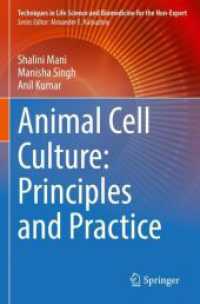- ホーム
- > 洋書
- > 英文書
- > Nature / Ecology
Full Description
After the chicken, the House Sparrow is the most widely distributed bird species in the world, occurring on all continents except Antarctica and on most human-inhabited islands. Although its Latin name is Passer domesticus, it is certainly not domesticated. In fact, it is widely regarded as a pest species and is consequently not protected in most of its extensive range. This combination of ubiquity and minimal legal protection has contributed to its wide
use in studies by avian biologists throughout the world. The purpose of this book is to review and summarize the results of these global studies on House Sparrows, and to provide a
springboard for future studies on the species. House Sparrows have been used to study natural selection in introduced species, circadian rhythms, and the neuroendocrine control of the avian annual cycle. One current question of considerable interest concerns the catastrophic House Sparrow population declines in several urban centers in Europe. Is the House Sparrow a contemporary canary in the mine? Other topics of broad interest include the reproductive and flock-foraging strategies of
sparrows, and sexual selection and the function of the male badge in the species. Anderson also explores the role of the House Sparrow in disease transmission to humans and their domesticated animals.
Contents
1: TAXONOMY AND DISTRIBUTION
The Genus passer
The Origin of P. Domesticus
Passer domesticus
Distribution of the House Sparrow
Range Expansion in the House Sparrow
2: EVOLUTION AND GENETICS
Professor Bumpus and His Sparrows
Natural Selection in Introduced Sparrows
Genetics of the House Sparrow
3: ANNUAL CYCLE
The Gonadal Cycle
Circadian Rhythmicity
4: BREEDING BIOLOGY AND REPRODUCTIVE STRATEGY
Age at First Reproduction
Mating System
Timing of Breeding
Nest Sites and Nests
Egg Laying and Clutch Size
Egg size and Composition
Incubation and Hatching
Nestling Growth and Survival
Number of Broods and Cessation of Breeding
Reproductive Lifespan
Captive Breeding
5: PLUMAGES AND MOLT
Plumage Description
Pterylosis
Molt
Ptilochronology
Plumage Maintenance
Incubation Patch
Badge Size in Males
6: FORAGING BEHAVIOR AND FOOD
Foraging Strategy of the House Sparrow
Diet of the House Sparrow
7: SOCIAL BEHAVIOR AND VOCALIZATIONS
Vocalizations
Displays
Communal Roosting
8: POPULATION DYNAMICS AND MOVEMENTS
Decline in House Sparrow Numbers
Predation
Parasitism and Disease
Interspecific Competition
Changes in Agricultural Practices
Survival Rates
The Sex Ratio Conundrum
Movements
Where Have All the Sparrows Gone?
9: ANATOMY AND PHYSIOLOGY
Integrumentary System
Skeletal System
Muscular System
Nervous System
Endocrine System
Circulatory System
Respiratory System
Digestive System
Excretory System
Reproductive System
Body Mass and Composition
10: HUMAN COMMENSALISM AND PEST MANAGEMENT
Obligate Commensal?
Pest Status
Pest Management
Positive Impacts of Sparrows
Sociology of Sparrows
Appendix
Literature Cited
Index








